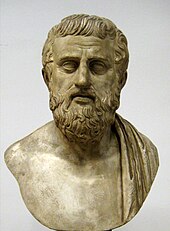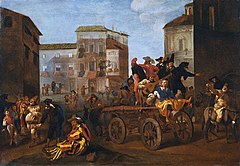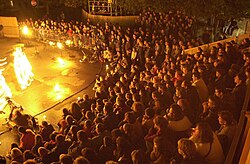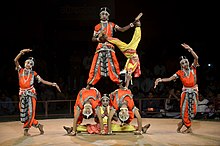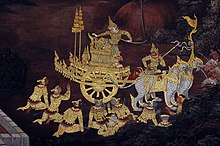Performing arts
The performing arts are those artistic manifestations created to be represented on stage. Although there are basically three artistic disciplines that are represented in the performing arts (theatre, dance and music), these are at your disposal. Sometimes they are subdivided or combined into many others, such as opera, zarzuela, musical theater, performance, cabaret, recital, puppets, puppets or the circus, among others. The stage, due to its In part, they can be in buildings specially designed for this, such as theaters, performance halls and multipurpose rooms, or they can take advantage of urban or architectural spaces of a public nature, as occurs in street performances such as the circus or the comedy of art. Even non-artistic forms such as parades, religious processions, popular festivals or carnivals have a very clear scenic dimension and are often taken into account by performing arts.
History
Western Performing Arts
From the VI century a. C., the classical period of the performing arts begins in Greece, which was inaugurated by tragic poets such as Sophocles. These poets wrote plays that, in some cases, incorporated dance (see Euripides). The Hellenistic period initiated the widespread use of comedy.
However, in the VI century d. C., Western performance arts had largely ended at the onset of the Dark Ages. Between the 9th century and the XIV, scenic art in the West was limited to religious historical representations and morality plays, organized by the Church to celebrate holidays and other important events.
Renaissance
In the 15th century, the performing arts, along with the arts in general, experienced a renaissance as the The Renaissance began in Italy and spread throughout Europe with plays, some of which incorporated dance, performed, and Domenico da Piacenza is credited with the first use of the term ballo (in De Arte Saltandi et Choreas Ducendi) instead of dance for his baletti or balli. The term ended up becoming Ballet. The earliest Ballet per se is believed to be Balthasar de Beaujoyeulx's Ballet Comique de la Reine (1581).
In the mid-16th century 16th Commedia Dell'arte became popular in Europe, introducing the use of the improvisation. This period also introduced the Elizabethan mask, with music, dance and elaborate costumes, as well as professional theater companies in England. William Shakespeare's plays of the late 16th century developed from this new kind of professional performance.
In 1597, the first opera, Daphne, was performed, and over the course of the 17th century, the opera would become It quickly became the entertainment of choice for the aristocracy of most of Europe and eventually for large numbers of people living in cities and towns across Europe.
Modern Age
The introduction of the proscenium arch to Italy during the 17th century established the traditional theater form that persists to this day. Meanwhile, in England, the Puritans banned acting, leading to a hiatus in the performing arts that lasted until 1660. From then on, women began to appear in French and English plays. The French introduced a formal teaching of dance in the late 17th century century.
It was also around this time that the first plays were performed in the American Colonies.
During the 18th century, the introduction of the popular opera buffa brought opera to the masses as an accessible form of representation. [The "Marriage of Figaro" and "Don Giovanni" by Wolfgang Amadeus Mozart are landmarks of opera from the late 18th century century.
At the end of the 19th century, Beethoven and the Romantic movement ushered in a new era that led first to spectacles of grand opera and then to the musical dramas of Giuseppe Verdi and the Gesamtkunstwerk (total work of art) of Richard Wagner's operas which led directly to the music of the century XX.
The 19th century was a period of growth for the performing arts for all social classes, technical advances such as the introduction of gaslight in theaters, burlesque, minstrel dancing, and variety theater. In ballet, women make great strides in an art hitherto dominated by men.
Modern dance began in the late 19th century and early XX as a response to the restrictions of traditional ballet. The advent of Sergei Diaghilev's Ballets Russes (1909-1929) revolutionized ballet and the performing arts in general throughout the Western world, not least thanks to Diaghilev's emphasis on collaboration, bringing together choreographers, dancers, set designers/artists, composers and musicians to revitalize and revolutionize ballet. It is extremely complex.
Konstantin Stanislavski's The Stanislavski System revolutionized acting at the turn of the XX century and continues to have a major influence on actors theater and screen to the present. Both Impressionism and Modern Realism entered the scene during this period.
With the invention of cinema at the end of the 19th century by Thomas Edison and the growth of the film industry in Hollywood in the early 20th century, film became a dominant performance medium throughout the 20th and 21st centuries.
Rhythm and blues, a cultural phenomenon in black America, rose to prominence in the early 20th century, influencing a number of later internationally popular musical styles.
In the 1930s, Jean Rosenthal introduced what would become modern stage lighting, changing the nature of the stage as the Broadway musical became an American phenomenon.
Postwar
Post World War II performing arts were notable for the revival of ballet and opera in the Western world.
Postmodernism in the performing arts largely dominated the 1960s.
Performing Arts of the East
Middle East
The oldest recorded theatrical event dates back to the year 2000 BC. C. with the works of the passion of Ancient Egypt. The story of the god Osiris was enacted annually at festivals throughout civilization, marking the known beginning of a long relationship between theater and religion.
The most popular forms of theater in the medieval Islamic world were puppet theater (which included hand puppets, shadow plays, and puppet productions) and live passion plays known as ta'; ziya, in which the actors acted out episodes from Muslim history. In particular, the works of Shia Islam revolved around the shaheed (martyrdom) of Ali's sons, Hasan ibn Ali and Husayn ibn Ali. Live secular plays were known as akhraja, recorded in medieval adab literature, although they were less common than puppet theater and tata'. ziya.
Iran
In Iran there are other forms of theatrical manifestations such as Naghali or Naqqāli (storytelling), ٰRu-Howzi, Siah-Bazi, the Parde-Khani and the Mareke giri. Before the 20th century, storytelling was the most recognized form of entertainment, although some forms still exist today. One form, the Naghali, was traditionally performed in cafés, where the storytellers, or Naghals (Naqqāls), only recited sections of one story at a time, thus preserving the regular clientele. These stories were based on events of historical or religious significance and many made reference to Shahnameh's poetry. Often these stories were modified to suit the atmosphere or mood of the audience.
Indian
Folk theater and stage performances date back to the religious ritualism of the Vedic peoples in the 2nd millennium BC. C.. This folk theater of the misty past was mixed with dance, food, ritualism and the representation of events of daily life. This last element made it the origin of the classical theater of later times. Many historians, notably D. D. Kosambi, Debiprasad Chattopadhyaya, Adya Rangacharaya, etc., have referred to the prevalence of ritualism among the Indo-Aryan tribes in which some tribesmen acted as if they were wild animals and others were the hunters. The ones that acted like mammals like goats, buffaloes, reindeer, monkeys, etc. they were persecuted by those who played the role of hunters.
Bharata Muni (circa V-II BCE) was an ancient Indian writer best known for having written the Natya Shastra of Bharata, a theoretical treatise on the Indian performing arts, including drama, dance, acting and music, which has been compared to Aristotle's Politics. Bharata is often known as the father of Indian theater arts. His Natya Shastra seems to be the first attempt to develop the technique, or rather the art, of drama in a systematic way. The Natya Shastra tells us not only what to act out in a drama, but how to do it. Drama, as Bharata Muni says, is the imitation of men and their actions (loka-vritti). Because men and their actions must be respected on stage, drama is also known in Sanskrit by the term roopaka, which means performance.
The Ramayana and the Mahabharata can be considered the first recognized plays to originate in India. These epics inspired the early Indian dramatists and continue to do so to this day. Indian playwrights like Bhāsa in the 2nd century century BCE. C. wrote works highly inspired by the Ramayana and the Mahabharata.
Kālidāsa, in the I century B.C. C., is considered the greatest playwright of ancient India. Three famous romantic works written by Kālidāsa are the Mālavikāgnimitram (Mālavikā and Agnimitra), Vikramōrvaśīyam (Relating to Vikrama and Urvashi), and Abhijñānaśākuntala (The recognition of Shakuntala). The latter was inspired by a story from the Mahabharata and is the most famous. It was the first to be translated into English and German. Compared to Bhāsa, who relied heavily on epics, Kālidāsa can be considered an original dramatist.
The next great Indian dramatist was Bhavabhuti (c. VIIth century century). It is said that he wrote the following three works: Malati-Madhava , Mahaviracharita and Uttar Ramacharita . Of these three, the last two cover the epic of the Ramayana. The mighty Indian emperor Harsha (606-648) is credited with writing three plays: the comedy Ratnavali, Priyadarsika, and the Buddhist drama Nagananda. i>. Many other playwrights followed during the Middle Ages.
There were many forms of performing art in South India, Kerala is a state with different forms of art like Koodiyattam, Nangyarkoothu, Kathakali, Chakyar koothu, Thirayattam and there were many prominent performers like Painkulam Raman Chakyar and others.
Chinese
There are references to theatrical entertainment in China as early as 1500 B.C. C. during the Shang dynasty; they often included music, antics, and acrobatic displays.
The Tang Dynasty is sometimes referred to as the "era of 1000 entertainments". During this time, Emperor Xuanzong formed an acting school known as the Children of the Pear Garden to produce a form of theater that was primarily musical.
During the Han dynasty, shadow puppetry first emerged as a recognized form of theater in China. There were two different forms of shadow puppets, the southern Cantonese and the northern Pekingese. The two styles were differentiated by the method of making the puppets and the placement of the rods in the puppets, as opposed to the type of work represented by the puppets. Both styles generally staged plays depicting high adventure and fantasy, and this highly stylized form of theater was rarely used for political propaganda. The Cantonese shadow puppets were the larger of the two. They were made of thick leather that created more substantial shadows. The symbolic color was also very frequent; a black face represented honesty, a red one bravery. The rods used to control Cantonese puppets were attached perpendicular to the puppets' heads. Thus, the public did not see them when the shadow was created. The Pekingese puppets were more delicate and smaller. They were created from a thin, translucent leather that was usually taken from the belly of a donkey. They were painted with vibrant paints, so they cast a very colorful shadow. The fine rods that controlled its movements were attached to a leather collar on the puppet's neck. The rods ran parallel to the puppet's body and then rotated through a ninety degree angle to connect to the neck. Although these rods were visible when the shadow was cast, they were outside the shadow of the puppet, so they did not interfere with the appearance of the figure. The rods were attached to the necks to facilitate the use of several heads with a single body. When the heads were not in use, they were kept in a muslin book or cloth-lined box. The heads were always removed at night. This responds to the old superstition that, if left intact, the puppets will come to life at night. Some puppeteers even kept the heads in one book and the bodies in another, to further reduce the possibility of reanimating the puppets. Shadow puppets are said to have reached their artistic peak in the 11th century before becoming a tool of government.
In the Song Dynasty, there were many popular plays that included acrobatics and music. A more sophisticated form with a structure of four or five acts developed in the Yuan dynasty. Yuan theater spread throughout China and diversified into numerous regional forms, the best known of which is Peking Opera, which remains popular today.
Thailand
In Thailand, it has been traditional since the Middle Ages to stage plays based on plots drawn from Indian epics. In particular, the stage version of the Thai national epic Ramakien, a version of the Indian Ramayana, remains popular in Thailand even today.
Cambodia
In Cambodia, inscriptions dating back to the VI century AD. C. indicate the existence of dancers in a local temple and the use of puppets for religious works. In the ancient capital Angkor Wat, stories from the Indian epics Ramayana and Mahabharata have been carved on the walls of temples and palaces. Similar reliefs are found at Borobudur in Indonesia.
Philippines
In the Philippines, the famous epic poem Ibong Adarna, originally titled "Korido at Buhay na Pinagdaanan ng Tatlong Prinsipeng Magkakapatid na anak nina Haring Fernando at Reyna Valeriana sa Kahariang Berbania" (English: "Corrido y Vida Vida por los Tres Príncipes, hijos del Rey Ferdinando y la Reina Valeriana en el Reino de Berbania") del siglo XVI was written by José de la Cruz during the Spanish era. Apart from the stage performances, different films were produced by different film studios/TV productions. The first produced film "Ang Ibong Adarna" It was produced by LVN Pictures, the largest movie studio in Philippine history.
Florante at Laura is an awit' or poem composed of 12-syllable quatrains with the full title "Pinagdaanang Buhay ni Florante at ni Laura sa Kahariang Albanya&# 34; (English: "The story of Florante and Laura in the Kingdom of Albania") was written by Francisco Balagtas in 1838 during his imprisonment, dedicated to his love interest María Asuncuión Rivera (nicknamed &# 34;M.A.R.", which he refers to as "Selya"). The poem has a special part titled "Kay Selya" (English: "For Celia") specially dedicated to Rivera.
The national hero of the Philippines, José Rizal who is also a novelist, created the two famous poems in the Philippines, Noli Me Tángere (Latin for "Don't touch me", with a acute accent added on final word in accordance with Spanish orthography) (1887) describing the perceived inequalities of Spanish Catholic friars and the ruling government and El Filibusterismo (translations: El filibusterismo; The Subversive or Subversion, as in Locsín's English translation, are also possible translations, also known by its alternate English title The Reign of Greed) (1891). The dark theme of the novel is a drastic departure from the hopeful and romantic atmosphere of the previous novel, which means that Ibarra resorts to solving his country's problems by violent means, after his previous attempt to reform the system of the country had no effect and seemed impossible with the corrupt attitude of the Spanish towards the Filipinos. These novels were written during the colonization of the Philippines by the Spanish Empire.
All of these literary works were within the K-12 Program curriculum for secondary schools, Ibong Adarna is within the 7th grade curriculum; Florante in Laura (8th grade); Noli Me Tangere (9th grade); and El Filibusterismo (10th grade).
Japan
During the 14th century, there were small troupes of actors in Japan who performed short, sometimes vulgar comedies. The director of one of these companies, Kan'ami (1333-1384), had a son, Zeami Motokiyo (1363-1443), who was considered one of the greatest child actors in Japan. When Kan'ami's company performed for Ashikaga Yoshimitsu (1358-1408), the shōgun of Japan, implored Zeami that he had an education at court for his arts. After Zeami succeeded his father, he continued to perform and adapt his style to what is now Noh. Mixing pantomime and vocal acrobatics, the Noh style of theater has become one of the most refined forms of theatrical performance in Japan.
Japan, after a long period of civil wars and political disorder, was unified and at peace mainly thanks to shōgun Tokugawa Ieyasu (1600-1668). However, alarmed by the growing number of Christians within the country due to the proselytizing efforts of Christian missionaries, he cut Japan's contact with Europe and China and outlawed Christianity. When peace came, the burgeoning of cultural influence and the growing merchant class demanded their own entertainment. The first form of theater to flourish was Ningyō jōruri (commonly known as Bunraku). The founder and main contributor to Ningyō jōruri, Chikamatsu Monzaemon (1653-1725), turned his form of theater into a true art. Ningyō jōruri is a highly stylized form of theater using puppets, today approximately 1⁄3rd size human. The men who control the puppets train their entire lives to become master puppeteers, at which point they can operate the head and right arm of the puppet and choose to show their faces during the performance. The other puppeteers, who control the less important members of the puppet, cover themselves and their faces with a black suit, to imply their invisibility. The dialogue is handled by a single person, who uses various tones of voice and ways of speaking to simulate different characters. Chikamatsu wrote thousands of works during his lifetime, most of which are still in use today.
Kabuki began shortly after Bunraku, according to legend, by an actress named Okuni, who lived towards the end of the 16th century. Most of the material in kabuki comes from Noh and Bunraku, and its erratic dance-like movements are also an effect of Bunraku. However, kabuki is less formal and more aloof than Noh, but very popular with the Japanese public. Actors train in a wide variety of things, including dance, singing, pantomime, and even stunts. Kabuki was performed first by young girls, then by young boys, and by the late 16th century, kabuki troupes were made up exclusively of men. The men who represented the women on stage were specifically trained to get the essence of a woman in her subtle movements and gestures.
History of Performing Arts in Oceania
Often, Melanesian dance exhibits a cultural theme of masculinity where leadership and a unique skill set are important to share with the community. These dances demonstrate a man's soldiery; however, they can also represent payoff such as fostering conflict resolution or healing. The impersonation dancers' costumes incorporate large masks and non-human features that act to imitate mythical figures. Music can also act as a voice for these magical characters.
Scenic space
The performing arts space, apart from notable differences produced by the different concepts of the show and everything related to this world, have had to change throughout history, they maintain an unalterable arrangement of areas depending on of the use made of them. When this happens we have to use artifacts that can help us, it refers to those areas that are going to house the two essential elements for the work to take place: the actors and the public.
Additionally, the stage spaces have been modified to meet modern needs. Technology has been the biggest contributor since in the most professional spaces, such as the theater, lights and audio have been omitted that increase the audiovisual experience for the viewer. However, street works do imply more practical effects.
History of Performing Arts
The Performing Arts have important historical backgrounds, ranging from shamanic rituals to celebrate spring, to the Greek Tragedy and the Panhellenic Games of Ancient Greece, or the Floral Games of the later Roman Empire and the Sacred Christian Theater.
This type of performance has always been central to the cultural life of nations, since it has, especially theater, an important political dimension.
It is assumed, based on cave images and other evidence, that music would have appeared first, then dance and finally theater as a complex form of the latter. Its most recent aspects are those close to cinema, whose cinematography technique would not be invented until the XIX century.
Religious origin and function
The sacred theater is as old as the theater itself, as it can be considered its cause of appearance. Along with the Olympic and the other Panhellenic Games (Pythian, Isthmian and Nemean) the Greek theater was born as one more of the sacred musical and poetic competitions (as in Rome would be the floral games). The considered founder of the theater, Thespis, was for being the first winner of one of these contests: the Dionysias of Athens (536 BC). The theater immediately acquired, especially in tragedies, an evident ritual and spiritual function. He emphasized its purifying function (the catharsis) as well as the transmission of high moral values; and to inform the spectators of their role as men and citizens within the polis and the cosmos along with other men and the gods, and invited them to identify themselves with the heroes driven by their destiny on a transcendent mission.
Asian civilizations developed performing arts also with deep religious and social meanings, among which the reproduction and experience of myths reached the greatest importance (Chinese theater, Japanese theater, Indonesian culture, Bali theater -ketchak , collective representation of the highly expressive Ramayana-)
The sacro-Christian theatre, the immediate precedent of the classical European theater of the Renaissance and the Baroque, arose in the Middle Ages (liturgical drama, sacramental play, mystery (theatre), morality (theatre); and together with sacred music it had in the churches and cathedrals the scenic context for which it was conceived.
Contenido relacionado
Paleontology
New Testament
History of Spain

